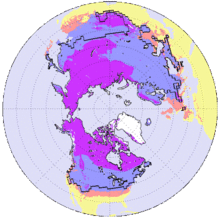Polar regions of Earth

The polar regions, also called the frigid zones or polar zones, of Earth are Earth's polar ice caps, the regions of the planet that surround its geographical poles (the North and South Poles), lying within the polar circles. These high latitudes are dominated by floating sea ice covering much of the Arctic Ocean in the north, and by the Antarctic ice sheet on the continent of Antarctica and the Southern Ocean in the south.
Definitions
The Arctic has various definitions, including the region north of the Arctic Circle (currently Epoch 2010 at 66°33'44" N), or just the region north of 60° north latitude, or the region from the North Pole south to the timberline. The Antarctic is usually defined simply as south of 60° south latitude, or the continent of Antarctica. The 1959 Antarctic Treaty uses the former definition.
The two polar regions are distinguished from the other two climatic and biometric belts of Earth, a tropics belt near the equator, and two middle latitude regions located between the tropics and polar regions.
Climate
Polar regions receive less intense
The
Circumpolar Arctic region
There are many settlements in Earth's north polar region. Countries with claims to Arctic regions are: the United States (Alaska), Canada (Yukon, the Northwest Territories and Nunavut), Denmark (Greenland), Norway, Finland, Sweden, Iceland, and Russia. Arctic circumpolar populations, though small, often share more in common with each other than with other populations within their national boundaries. As such, the northern polar region is diverse in human settlements and cultures.
Antarctica and the Southern sea

The southern polar region has no permanent human habitation as of now.[1] McMurdo Station is the largest research station in Antarctica, run by the United States. Other notable stations include Palmer Station and Amundsen–Scott South Pole Station (United States), Esperanza Base and Marambio Base (Argentina), Scott Base (New Zealand), and Vostok Station (Russia).
While there are no indigenous human cultures, there is a complex ecosystem, especially along Antarctica's
See also
References
- ^ Matthew Teller (20 June 2014). "Why do so many nations want a piece of Antarctica?". BBC. Retrieved 22 March 2019.
Further reading
- Victor, Paul-Émile. Man and the Conquest of the Poles, trans. by Scott Sullivan. New York: Simon & Schuster, 1963.[ISBN missing]
External links
- Polar regions at Curlie
- The Polar Regions
- International Polar Foundation
- Arctic Environmental Atlas (UNDP)
- Earth's Polar Regions on Windows to the Universe
- Arctic Studies Center, Smithsonian Institution
- Scott Polar Research Institute, University of Cambridge
- WWF:The Polar Regions
- World Environment Day 2007 "Melting Ice" image gallery at The Guardian
- Polar Discovery
